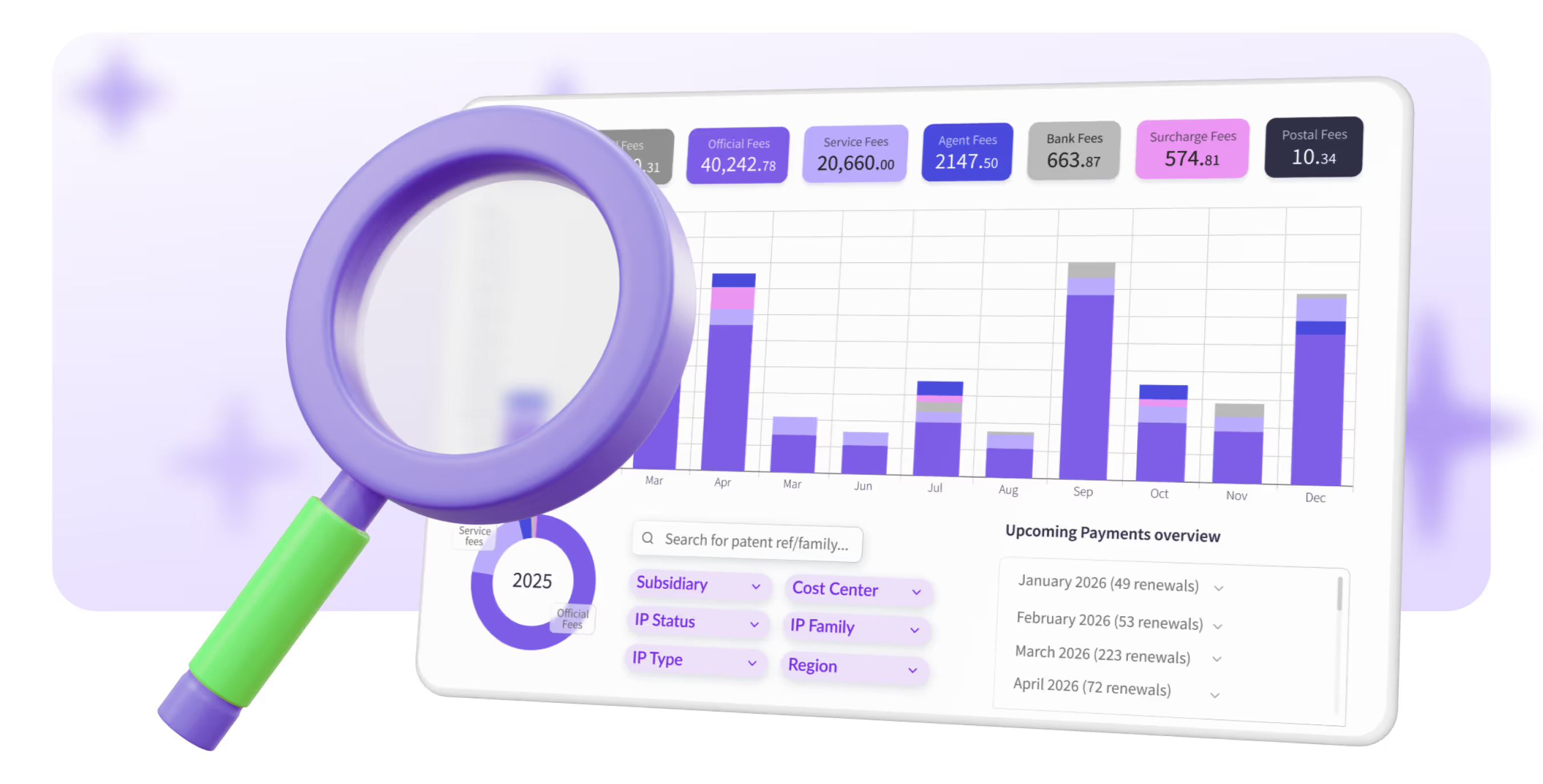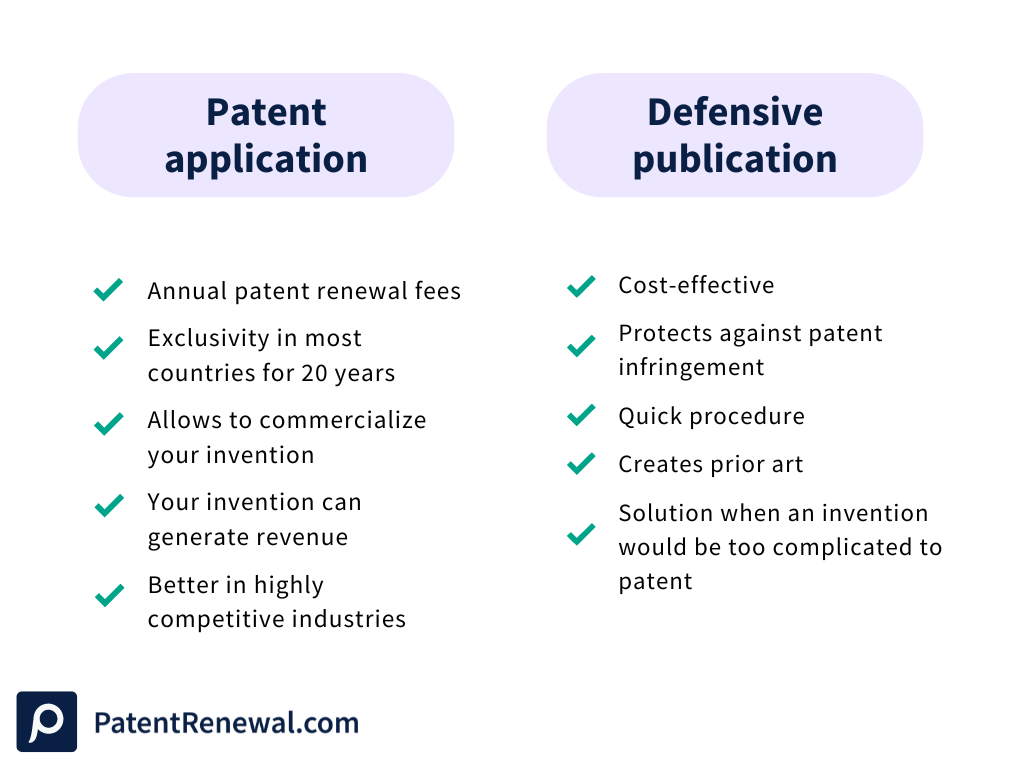TRY OUR NEW (FREE) IP RENEWAL COST CALCULATOR
Calculate
.avif)
Understanding your intellectual property protection options is essential to an effective IP management strategy. This blog post explores the differences between patents and defensive publications and provides insight into how to make a smarter choice between the two.
A defensive publication is a disclosure that provides no patent protection to the publisher but can create prior art against others as of the publication date. This approach eliminates the exclusive rights granted by a patent, but it also avoids the process of annual patent maintenance.
With this choice, inventors can reduce costs and administrative burdens while still protecting their innovations from being claimed by others. A defensive publication can include any public announcement that contains the essential details or function of an intellectual property asset. It is similar to a conventional patent, which demonstrates the practicality of the technology and confirms its originality, utility, and non-obviousness.
According to the European Patent Office, the European practice requires defensive publications to be described with all relevant details, published in a searchable way for public search engines under the relevant keywords and it has to indicate when and where it was published.
While patents provide inventors long-term exclusive rights to their innovations and play a more critical role in competitive industries, in some cases, it's still better to use a defensive publication when your company needs a quick and more cost-effective solution. For example in rapidly developing industries such as the tech industry:
“Recent trends have shown that the tech industry is moving at lightning speed, making it crucial for startups like ours to stay ahead of the game when it comes to protecting our intellectual property. While patent applications offer strong protection, defensive publication can be a quicker and more cost-effective strategy in some cases. By closely monitoring market trends and competitor activities, we can make informed decisions on whether to pursue patents or opt for defensive publications to safeguard our innovations without breaking the bank. Remember, in the fast-paced world of tech, adaptability is key!” - Alex Stasiak (CEO & Founder - Startup House)
One of the biggest benefits of the defensive publication is definitely cost-effectiveness. Patents come with initial filing fees, transaction fees, in some cases patent attorneys’ fees, and yearly patent maintenance fees depending on the country.
Defensive publications eliminate many of these expenses. The cost of publication varies depending on the publisher's needs, ranging from formal to informal. Self-publishing can be costless for example, but in the case of a more professional publication, the fee depends on the service provider. Innovators can hire a defensive publication service, or pay to publish through an academic journal.
Another important factor to consider is how you want to benefit from your invention in the future. If you expect to gain profit from your invention, then a patent is worthwhile; if you do not expect a significant return, then a defensive publication may be a better option.
“The dividing line between whether to publish a defensive publication or file a patent application is the projected return on investment (ROI). Provided the projected ROI for an invention is sufficiently high, filing a patent application is the better option. But absent such an ROI, a defensive publication is a cost-effective solution to publish information about your invention and prevent others from patenting it.” - Ken Horton (Adjunct Professor - University of Utah Law School)
Patents offer strong legal protection, meaning that others cannot commercially make, use, distribute, import, or sell the invention without the patent owner's consent. However, these require a high level of enforcement and constant IP maintenance, which can be complex without the right IP management software. In most countries, patents need to be renewed annually, requiring continuous attention to ensure timely renewal and protect the IP from potential imitations.
Defensive publications do not have the same legal protection, but they offer simplicity and security. They do not require annual renewal or IP management but still prevent others from patenting the same innovation. This ensures that no one else can receive exclusive rights to it, because if the patent office examiners find that a patent application is based on ideas that already exist, the patent cannot be granted, since existing publications can serve as key evidence in a legal dispute to argue the novelty of the innovation.
The choice between the two depends on the nature of the invention and the invention’s market objectives.
“In our organization, we opted for defensive publication over patenting when we developed a novel algorithm that we believed could greatly benefit the industry. By publishing the algorithm, we aimed to establish prior art and prevent competitors from patenting similar technologies, fostering innovation and ensuring widespread adoption. Conversely, we pursued patent protection for our flagship product, as it represented a unique market opportunity where exclusivity was crucial for maintaining a competitive edge and securing investment.” - Madison T (Ecommerce Manager - My Supplement Store)

Understanding the difference between patents and defensive publications is key in IP management. The optimal choice depends on your specific circumstances and business strategy since each pathway has its unique benefits and drawbacks. If you would like to learn more about different intellectual property types check out our previous blog post.
Experience how our automated patent maintenance platform can transform your IP management. Find out more about our solution to protect your IP in the most efficient and cost-effective way.
Interested in a free IP renewal consultation? Benchmark your current IP renewal setup and costs against market standards.
